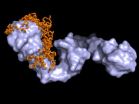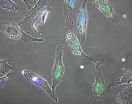(Press-News.org) This news release is available in German.
Wetlands, including peatlands, have a high content of humic substances, which are organic compounds that form during incomplete decomposition of biomass. Under anoxic conditions, soil bacteria can use these organic compounds during respiration as electron acceptors. Many organisms (including us humans) instead use oxygen as the electron acceptor.
In the mid-1990s, researchers revealed that some anaerobic microorganisms in soils and sediments use humic substances as electron acceptors under anoxic conditions. However, the capacity of these substances to accept electrons is limited. Once the capacity is reached (i.e., the battery is fully charged), the bacteria in anoxic systems utilize other electron acceptors. If carbon dioxide is used as electron acceptor, the potent greenhouse gas methane is formed. Wetlands are responsible for fifteen to forty per cent of the global methane flux into the atmosphere. However, many wetlands release less methane than expected based on their areas and the microbial activity in these systems. This finding suggests that there are natural processes that suppress methane formation.
In a study published in Nature Geoscience, researchers including Dr. Michael Sander, a senior scientist in the Environmental Chemistry Group of ETH-Zurich Professor Kristopher McNeill, have now presented a process that likely contribute to the comparatively small releases of methane.
Humic substances short-circuit electrons to oxygen
With the aid of a model system, the researchers demonstrated that the capacities of humic substances to accept electrons can be fully regenerated if the humic substances charged by the microorganisms are periodically brought in contact with oxygen. The charged humic substances then release the electrons they have accepted under oxygen-free conditions to the newly introduced oxygen. If the system subsequently turns anoxic again, the bacteria may again use the humic substances as electron acceptors, thereby supressing the number of electrons that are transferred to carbon dioxide. Consequently, this process of short-circuiting electrons from anaerobic respiration via humic substances to oxygen may suppress the formation of methane in natural systems that are periodically anoxic and that contain a high content of humic substances.
In their lab model, the researchers used the bacterium Shewanella oneidensis MR-1, which was originally isolated from the sediment of a lake in New York State and which is easily cultivated in the lab. This organism is a facultative anaerobe bacterium, which means that it can live under both anoxic and oxic conditions. The researchers used four different well-characterized humic substances as electron acceptors.
Implications for wetlands
The results of this study contribute to a better understanding of carbon dynamics in temporarily anoxic wetlands. The process described in the study is expected to occur on a large scale, for instance in peatlands. If the water level in a peatland drops, oxygen enters into parts that were previously anoxic. The humic substances in these parts, which were charged by microorganisms in the absence of oxygen, then release the electrons to oxygen and thereby regenerate their capacity to accept electrons. Peatland soils therefore work like gigantic batteries that are periodically charged and discharged. This charging and discharging is expected to suppress the formation of methane in these systems.
The researchers estimated the extent to which this process supresses the formation of methane in northern peatlands. They estimated how many electrons humic substances accept under anoxic conditions and, under subsequent oxic condition, donate to oxygen. This estimation shows that methane emissions from these systems would be up to 170 per cent higher relative to the amount of methane that is currently released. "These results shows that electron transfer to and from humic substances is an important process with global implications," says Sander. In order to further investigate this process, the researchers will continue with lab studies and, in the coming summer, also conduct field measurements in a peatland in Central Sweden.
INFORMATION:
Further reading
Klüpfel L, Piepenbrock A, Kappler A, Sander M. Humic substances as fully regenerable electron acceptors in recurrently anoxic environments. Nature Geoscience 7,195–200(2014); DOI: 10.1038/ngeo2084
Peat soils as gigantic batteries
2014-02-28
ELSE PRESS RELEASES FROM THIS DATE:
Giant sunspot makes third trip across the sun
2014-02-28
A giant sunspot – a magnetically strong and complex region on the sun's surface – has just appeared over the sun's horizon. This is the third trip for this region across the face of the sun, which takes approximately 27 days to make a complete rotation.
Scientists track sunspots that are part of active regions, which often produce large explosions on the sun such as solar flares and coronal mass ejections, or CMEs. Each time an active region appears it is assigned a number. Active regions that have survived their trip around the back of the sun and reappear are assigned ...
New fast and furious black hole found
2014-02-28
A team of Australian and American astronomers have been studying nearby galaxy M83 and have found a new superpowered small black hole, named MQ1, the first object of its kind to be studied in this much detail.
Astronomers have found a few compact objects that are as powerful as MQ1, but have not been able to work out the size of the black hole contained within them until now.
The team observed the MQ1 system with multiple telescopes and discovered that it is a standard-sized small black hole, rather than a slightly bigger version that was theorised to account for all ...
Researchers discover unusual genetic mutation linked to adolescent liver cancer
2014-02-28
In the race for better treatments and possible cures, rare diseases are often left behind. In a collaboration of researchers at The Rockefeller University, Memorial Sloan Kettering Cancer Center and the New York Genome Center (NYGC), an unusual mutation has been found that is strongly linked to one such disease: a rare liver cancer that affects teens and young adults. The results, published this week in Science, suggest that the mutation plays a key role in the development of the disease, called fibrolamellar hepatocellular carcinoma, and may also underlie more common cancers ...
Retention leads to discipline problems in other kids
2014-02-28
DURHAM, N.C -- When students repeat a grade, it can spell trouble for their classmates, according to a new Duke University-led study of nearly 80,000 middle-schoolers.
In schools with high numbers of grade repeaters , suspensions were more likely to occur across the school community. Discipline problems were also more common among other students, including substance abuse, fighting and classroom disruption.
Public debate typically focuses on how retention affects an individual student's academic performance, said lead author Clara Muschkin. So she and her colleagues ...
Dangerous mistaken identity
2014-02-28
This news release is available in German.
Proteins like the so-called heat shock protein Hsp90 play an important role in almost all processes within human cells. They help other proteins fold into their three-dimensional structure or return damaged proteins back into their proper shape.
Recently, there has been increasing evidence indicating that the heat shock protein HSP90 may also be involved in the folding processes of the tau protein. Deposits of tau proteins in brain cells are typical for Alzheimer's disease and are held responsible for decaying nerve ...
Diabetes and obesity more common in socioeconomically deprived regions
2014-02-28
Living in a socioeconomically deprived region is a risk factor for being affected by diabetes mellitus and obesity. This holds true regardless of the individual social status of the inhabitants. This is the conclusion reached by scientists from the Institute of Health Economics and Health Care Management (IGM) at the Helmholtz Zentrum München (HMGU) and the Department of Epidemiology and Health Monitoring at the Robert Koch Institute (RKI) in Berlin. "Regional factors, such as the population's average income, unemployment or quality of the living environment can affect ...
Unearthing key function of plant hormone
2014-02-28
This news release is available in German.
Plants, like animals, employ hormones as messengers, which coordinate growth and regulate how they react to the environment. One of these plant hormones, auxin, regulates nearly all aspects of plant behavior and development, for example phototropism, root growth and fruit growth. Depending on the context, auxin elicits a range of responses such as cell polarization or division. In this week's edition of Science (DOI:10.1126/science.1245125), a team of researchers including Jiri Friml from IST Austria and led by Zhenbiao ...
Scientists discover the specific types of macrophages that affect Crohn's disease severity
2014-02-28
For those coping with Crohn's disease, a new research report published in the Journal of Leukocyte Biology offers hope for the development of new and more effective drugs. In the report, scientists show for the first time, precisely what type of immune cells are involved in driving the inflammation process in the disease. With this knowledge, new compounds can be identified which reduce the activity of these cells or lessen their inflammatory effects.
"By increasing the knowledge on the different macrophage subsets in the intestine and their blood counterparts, we hope ...
York physicists pave the way for more energy efficient technology
2014-02-28
An international team of scientists led by physicists from the University of York has paved the way for a new class of magnetic materials and devices with improved performance and power efficiency.
Magnetic materials are currently used to store almost all digital information. However, with information processing and storage now making up a significant fraction of the world's energy consumption, continuing improvements in energy efficiency will require new technologies and materials.
A promising development is all-optical thermally induced magnetic switching (TIMS), which ...
Emergency alert in the cell
2014-02-28
When an organism is exposed to life-threatening conditions, it sounds the alarm and a cellular emergency program, the heat shock response, is initiated. However, the name "heat shock response" is misleading. In the beginning of the 1960s, this form of stress response was first observed. Scientists exposed fruit flies to high temperatures and discovered a complex emergency program designated to save single cells and thus the organism itself. Today researchers know that this program is also triggered by other dangers such as radiation or toxic substances. The terminology, ...






